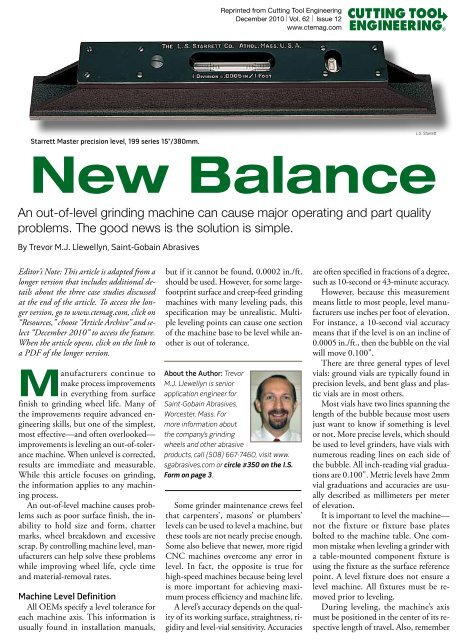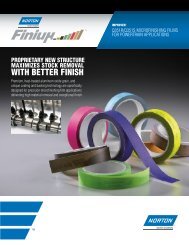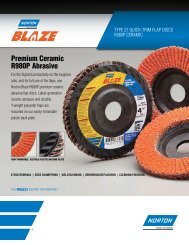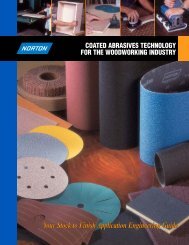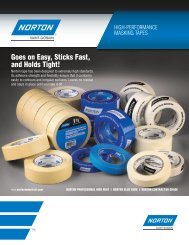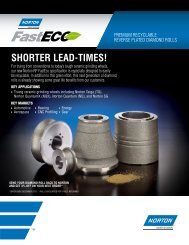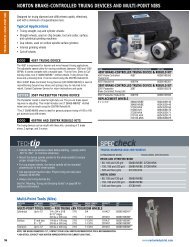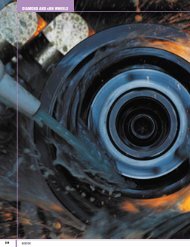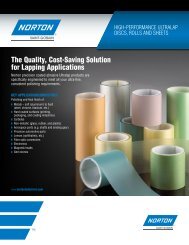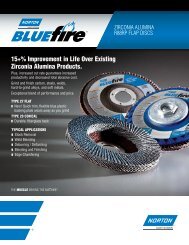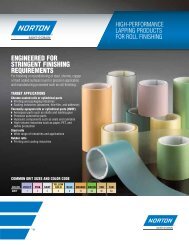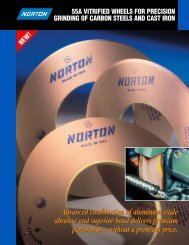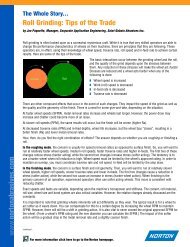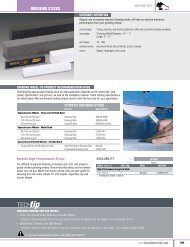New Balance - Norton
New Balance - Norton
New Balance - Norton
- No tags were found...
Create successful ePaper yourself
Turn your PDF publications into a flip-book with our unique Google optimized e-Paper software.
locks are suitable for elevatinga machine a few inches. Beyondthat, a raised concrete pad shouldbe poured.n Shops in a geographic area withseismic activity. Machinery locatedwest of the Rocky Mountains, for example,where earthquakes are morefrequent, requires monthly leveling.Case One: Optical Chatter MarksA customer making a component witha concave ground surface reported a longstandingproblem with chatter marks.The marks occurred only when the wheelOD wore to 15½" and 14". Thus, extrafinishing passes were required.the problem. Troubleshooting shifted tothe machine.The following observations were made:n the way lube system was operating 20percent below its specified pressure,n the OEM-specified way lube was notbeing used,n water was present in the way lubesystem filter bowl,n the machine level was off 0.001 in./ft. in the Z-axis and 0.0045 in./ft. inthe X-axis. The manufacturer’s tolerancewas 0.0004 in./ft. As a result,the machine bed was twisted, causingtight spots on the Y-axis.The machine was leveled to the OEM’sspecifications and the maintenance issueswere addressed, exceptfor the way lube oil specification.Several tests componentswere run and nochatter lines were observed.Three wheels were consumedafter the changes ontwo different setups, and noproblems were encountered.Eliminate Flood Coolant& Save Money!A typical grinding machine.While operating under standard parameters,the majority of the chattermarks occurred as the Y-axis was reversing.The marks were more of an opticalphenomenon than a measurable surfaceirregularity. Most occurred parallel to thegrind line; however, during some cyclesmarks ran at an angle to the grind line.Tests were performed with standardoperating parameters using a differentwheel specification. There was no significantchange in component surface quality.While applying the test wheel, thedress roll ratio was increased from +0.8to +0.85 and less chatter resulted. Theroll ratio was then increased to the maximumthe control would allow: +0.9.There was no improvement in surfacequality at +0.9 compared to +0.85.At this point, it became apparent thatthe root cause of the chatter problem laidelsewhere and that changing wheel specificationand parameters would not resolveCase Two: TheExpansion JointA manufacturer wasgrinding the mating facesof engine connecting rods,including a flat surface, verticalside wall and cornerradii. A problem with excessivewheel breakdown was reported inthe area of the radii. The rotating tableon which two identical fixtures weremounted was intermittently too slow inlocking down into position.After the X-axis made a rapid moveinto the X-axis start position, the Y-axismade a rapid move down to the grindstart position. The distance of the grindstart position from the periphery of thewheel to the components is about 0.003"and remains constant based on wheel diameter.If the rotating table is too slowin locking into position, the wheel willbe slightly chipped by the tang of the capand rod. Consequently, grinding commencedwith a chipped wheel.This explains why the problem alternatedbetween the cap and rod, becausethe table rotates both clockwise andcounterclockwise depending on whichfixture is being loaded.The machine was leveled to OEMUnited Grinding Technologiescall today: 800-452-5823www.rocolnorthamerica.comEnvironmentally-Safe Lubricants &Equipment for Near-Dry Machining
<strong>New</strong> <strong>Balance</strong> (continued)specifications and 20 cents worth ofgrease was pumped into the rotatingtable, which allowed it to free up.The result: 3,000 components wereground with full radii in specification.It was discovered that part of the problemwas the machine straddled a floorexpansion joint. Although it was impossibleto determine how much the jointhad moved since the machine was installed,movement had influenced themachine’s location.Power (hp)20151050-5-10-15Case Three: Faulty AssumptionsA newly rebuilt grinding machine wasable to run flat components to specification.However, when grinding a componentwith a profile or form, the machinecould not hold the required form tolerancesdue to wheel breakdown. Spindlepower and vibration data were recordedand analyzed.Vibration was suspected as the sourceof the problem. A vibration data acquisitiontool and a grind-cycle power monitorgathered data. These tools providedinformation on the dressing system andthe grinding wheel drive spindle. (Detailsregarding the benchmarking and dressingcycle modification can be found in theComparison Graph0 20 40 60 80 100 120 140 160 180 200Time (sec.)Part 1 prior to machine level Part 2 prior to machine level Part 1 after machine level Part 2 after machine levelSaint-Gobain AbrasivesFigure 1. Dressing diamond roll power curve. The pattern shows little part variation.online version of this article).A full cycle of vibration informationwas taken during the grind of both flatand profiled components. The vibrationanalysis output curves were similar, indicatingprocess consistency. However,slightly higher amplitudes were seen whilegrinding the profiled part. The highestrecorded amplitude was 0.1". While thisappears to be high, it was likely caused bymounting the sensor outside of the cantileveredguarding. The curve in Figure1 shows the power cycle for the process.Power and vibration analysis revealedno significant problems. It was then decidedto check the machine level and reversethe direction of the dress roll fromnegative to positive to open the wheel.Upon inspection, the machine wasnot even close to being level. Nothingregistered on the precision level in eitherthe X or Z axes. It was later determinedthe machine rebuilder assumed the userwould level it.After the machine was leveled, thegrinding process and slot feature tolerancesimproved. The slot was inspectedwith an optical comparator and cornerrounding of the slot was no longer anissue. Leveling this machine allowed precisionprofiling and flat grinding.In all three cases, machine unlevel wasthe biggest cause of grinding problems. Itaffected surface finish, form holding andpart geometry and caused chatter. This, inturn, negatively impacted tool life, cycletime, quality, amount of rework and, ultimately,operating cost.CTE


